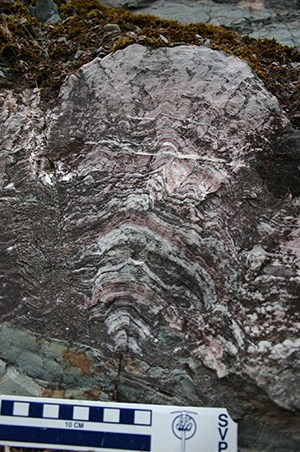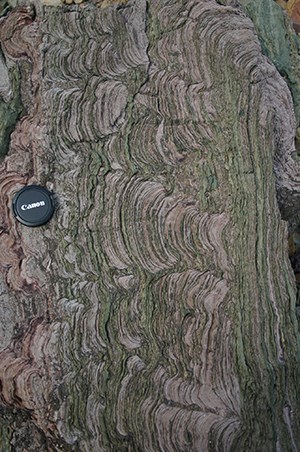Part of a series of articles titled Park Paleontology News - Vol. 10, No. 2, Fall 2018.
Article
The Stromatolites of Glacier National Park

Article by Rebecca K. Hunt-Foster, Paleontologist, Dinosaur NM
for Park Paleontology Newsletter, Fall 2018

Highway below the Loop.
NPS Photo / Rebecca Hunt-Foster

NPS Photo / Rebecca Hunt-Foster
The rugged high peaks of Glacier National Park are a beautiful sight to behold, with people traveling from all around the globe to experience this iconic setting. The rocks that compose those amazing peaks and valley walls hold the secrets to a time when this land was once covered by a vast shallow sea, a billion and a half years ago. At that time, Glacier National Park looked more like the modern day Bahamas, with clear waters holding some of the most primitive life forms on earth—cyanobacteria (blue-green algae)—which have been preserved in great abundance within these rocks. There are many geologic formations, or distinct zones of rock, exposed within the park, several of which contain the fossilized remains of these “algae,” called stromatolites. These fossils are mounds composed of sediment and cyanobacteria. Stromatolites are preserved when sediment is trapped and the algae grow over and through this sediment, creating alternating layers of algal mat and sediment. These often form mounds and columns that when grouped together form a type of reef called a bioherm. These microorganisms would have grown in shallow, clear, quiet waters. The absence of grazing animals allowed stromatolites to be a large and dominant life form at the time. Occasionally rocks are found in the park that contains large chunks of ripped-up fossilized algal mats. It is thought that these chunks formed during high-energy storms that would have torn up mats and redeposited them on the sea floor. These fossils were covered in sediment over time, eventually being compressed into rock and covered for hundreds of millions of years, before being thrust to the earth's surface some 70–80 million years ago during the formation of the Rocky Mountains. The recent glaciers that carved the amazing rock formations now seen in the park also helped to expose these fossils over time. With a trained eye or careful observation one can see the fossilized remains of stromatolites along much of the western portion of Going-to-the-Sun Road, Logan Pass, at the foot of Grinnell Glacier, and in numerous other places throughout the park.

NPS Photo / Rebecca Hunt-Foster
Some of the oldest stromatolites known from the park are found in the upper Altyn Limestone (1.35 to 1.45 billion years old) near Apikuni Falls. These were first described by two paleontologists, Carroll and Mildred Fenton, in 1931. One form, called Baicalia, is composed of columnar, branching stromatolites that would most likely have lived in near-shore “subtidal” areas. The other form, Collenia columnaris (also referred to as C. frequens), is composed of unbranched, highly elongated, and strongly inclined stromatolites that would have lived in the quiet waters below the tidal zone, and farther from shore. These stromatolites would have lived in tightly packed masses.
The claystones, or “argillites”, of the Appekunny and Grinnell Formations are well-known for their bright red and green rocks that can be seen in nearly every stream and lake within the park. These fine-grained rocks have been reported to contain the remains of stromatolites, although they are very rarely reported and often very small in size. Only one occurrence of these fossils from the Appekunny Formation is currently known. The Grinnell Formation has three documented occurrences of fossils. The mound-shaped stromatolites of the Grinnell are much smaller than their counterparts found in other formations within the park. The infrequent occurrences of fossils in these formations may likely be attributed to the high rate of land-derived sediments entering the sea, which would have clouded the waters and are characteristic of the resulting argillites. Clear waters necessary to promote photosynthesis are crucial for cyanobacterial survival.

NPS Photo / Rebecca Hunt-Foster
The Siyeh Formation (also called the “Helena Formation”) is by far the best exposed unit within the park. The formation crops out along the Going-to-the-Sun Road alongside the Garden Wall, up to the western flank of Going-to-the-Sun Mountain, in the Saint Mary Valley and in several other locations within the park, particularly in Two Medicine and the Many Glacier areas. This 1.1-billion-year-old limestone unit contains the abundant remains of stromatolites and stromatolite rip-up clasts. Mound, conical and dome-shaped stromatolites are abundant, and often found in bioherms. Many of these bioherms (also called “zones” and “cycles”) are laterally persistent and traceable for miles, and can be seen at the foot of Grinnell Glacier, along the Highline Trail leading to Granite Park Chalet, as you drive on the upper western section of Going-to-the-Sun Road, under the Logan Pass Visitor Center and surrounding area, and near Hole-in-the-Wall. One of these cycles is divided into six distinct units and comprises 70% of the actual volume of stromatolites within the Siyeh Formation.

NPS Photo / Rebecca Hunt-Foster
In higher elevations within the park and in sections along Highway 2 along the Park’s south-central boundary, the argillites, siltstones, and sandstone of the Snowslip Formation are exposed. The rocks of this unit were deposited in areas that would have been covered at high tide and/or exposed during low tide, with some occasional exposure above sea leve. “Pseudocolumnar” and mound-shaped stromatolites are known from five locations within the park. These stromatolites are often colorful alternating green and pink sediments. The stratigraphic unit directly above the Snowslip, the Shepard Formation, is found only in higher elevations within the park. Predominantly composed of dolomite, siltstones, argillite and quartzite, only mound- and columnar-shaped stromatolites have been described from this formation, most notably mound-shaped forms on Reynolds Mountain.
The great variety of stromatolite fossils at Glacier National Park comprises one of the richest accumulations of Precambrian life in the United States. These fossils help tell the deep history of the park, illustrate how the environment has drastically changed over the earth's long history, and are notably some of the oldest fossils preserved in any National Park Service unit.
Related Links
- Glacier National Park, Montana [Geodiversity Atlas] [Park Home]
- NPS—Fossils and Paleontology
- National Fossil Day Partnership
- NPS—Geology
Last updated: April 19, 2023
